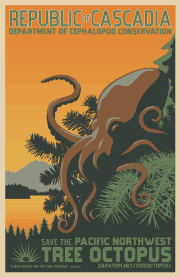4.1: Introducción al proceso de investigación
( \newcommand{\kernel}{\mathrm{null}\,}\)
- Identificar técnicas de búsqueda preliminares, intermedias y avanzadas
- Identificar métodos de análisis para evaluar la calidad y confiabilidad de una fuente
- Identificar temas de plagio y deshonestidad académica
- Identificar el formato de documentos MLA y las prácticas de citación
¿Por qué es necesario identificar componentes del proceso de investigación?
El pulpo arbóreo del noroeste del Pacífico

Figura4.1.1
Hace algunos años una especie animal poco conocida de repente llegó a los titulares. El encantador pero esquivo Tree Octopus se convirtió en el punto focal del escrutinio de Internet.
Si nunca has oído hablar del Pulpo Árbol del Noroeste del Pacífico, tómate unos minutos para conocer más sobre él en este sitio web, dedicado a salvar las especies en peligro de extinción.
También puedes ver este breve video para más sobre las criaturas:
Confiabilidad de la fuente

Figura4.1.2
Si estás empezando a tener la sensación de que algo no está del todo bien aquí, estás en el camino correcto. El sitio web de Tree Octopus es un engaño, aunque muy bien hecho. No existe tal criatura, desgraciadamente.
Muchos de nosotros sentimos que los “nativos digitales” —personas que han crecido usando Internet— son naturalmente conocedores de la web. Sin embargo, un estudio del Departamento de Educación de Estados Unidos de 2011 que utilizó el sitio web Tree Octopus como punto focal reveló que los estudiantes que encontraron este sitio web se enamoraron completamente de él. Según una noticia de la NBC de Scott Beaulieu, “De hecho, los estudiantes no solo creían que el pulpo árbol era real, sino que en realidad se negaron a creer a los investigadores cuando les dijeron que la criatura era falsa”. [1]
Si bien este es un ejemplo relativamente inofensivo de un sitio web de broma, ayuda a demostrar que cualquiera puede decir lo que quiera en internet. Un sitio web guapo puede ser muy convincente, independientemente de lo que diga. Cuanto más investigue, más verá que a veces los sitios web de menor aspecto profesional ofrecen la información más creíble, y los sitios web de aspecto más profesional pueden estar llenos de información sesgada, engañosa o completamente incorrecta.
No hay reglas duras y rápidas cuando se trata de confiabilidad de recursos. Cada nueva fuente tiene que ser evaluada por mérito propio, y este módulo te ofrecerá un conjunto de herramientas para ayudarte a hacer precisamente eso.
En este módulo, aprenderás sobre consejos y técnicas que te permitirán encontrar, analizar, integrar y documentar fuentes en tu investigación.


